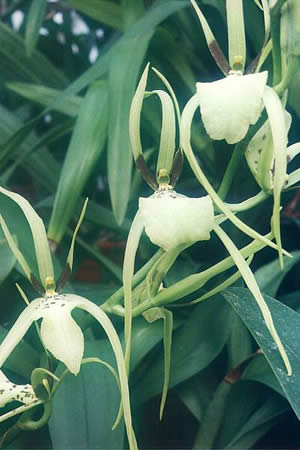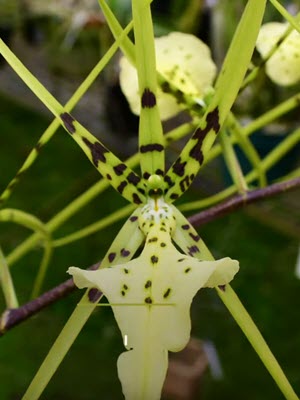Brassia Orchid Care
Contents
Brassia orchids are epiphytic plants from the Americas. They can be found from the southern parts of Florida in the United States, through the West-Indies and Central America, and in tropical parts of the South American continent. Most species are limited to a fairly specific area, but Brassia caudate is present over the whole geographic region. Brassia orchids grow in wet forests from sea level to an altitude of 1500 meters and this is important to remember if you want to provide your plants with ideal Brassia orchid care. Brassia orchids prefer an air humidity of 60% and growing them over a humidity tray is therefore a good idea if the air in your home is dry. Good air circulation is also important.

Brassia girouldiana orchid
In the floral trade, you can find Brassia orchid species as well as hybrids and they are appreciated primarily for their long, spreading tepals. Some Brassia orchids develop tepals that exceed 50 centimetres (1 feet 8 inches) in length. The spidery shaped flowers can be pale green or yellow (and related colours) and are decorated with brown bars. Since the flowers are spidery shaped, orchids from the genus Brassia are commonly known as Spider Orchids. You can read more about the reason for this spidery configuration in the trivia section below.
The Brassia genus is a part of the subtribe Oncidiinae. The genus derives its name from British botanist and illustrator William Brass, who worked with the famous botanist Sir Joseph Banks and collected plants in Africa. In the horticultural trade, the genus name is abbreviated Brs.
Watering
The Brassia orchids are epiphytic plants, which means that they grown on trees, not in the soil on the ground. They are therefore sensitive to over watering and should never be forced to stand with their roots in a soggy medium. Letting it dry out completely is however not recommended; water your Brassia orchid right before.
Nutrients
Brassia orchids usually appreciate a weakened orchid fertilizer solution that is applied 3 out of 4 waterings.
Temperature
A majority of the orchid species from the genus Brassia will do best when they are provided with cool nights and warmer days. Do not let the night temperature drop below 55-60 degrees F (13-16 degrees C).
Light
When it comes to light, the Brassia orchids have requirement similar to those of the more well known Cattleya orchids. Plenty of bright light is necessary, but the orchid should be shaded from the intense mid-day sun from 11 am to 3 pm. Dark green leaves are a sign of light insufficiency. Too strong sunlight can on the other hand cause yellowing of the leaves.
Potting medium
The epiphytic Brassia orchid must be given a potting medium with supreme draining capability. Medium to large bark is recommended. You can also mount your Brassia orchid to a piece of bark or wood, like it would grow in the wild.
Repotting a Brassia orchid
Repot your Brassia orchid every two to three years. Repot immediately if the potting medium starts to smell bad or is infested by mould or any other type of fungi.
Brassia species/h2>
Brassia orchid trivia!
The Brassia orchids rely on wasps of the genera Campsomeris and Pepsis for pollination. The female wasps from these two genera hunt spiders, and the Brassia orchids use mimicry to trick them into believing that a part of the orchid flower is a delicious spider. The wasp will sting the lip while trying to grasp what she thinks is a spider, touch the pollinarium, and consequently get pollen all over her head. When the wasp is lured into another Brassia orchid flower, pollination will take place.
